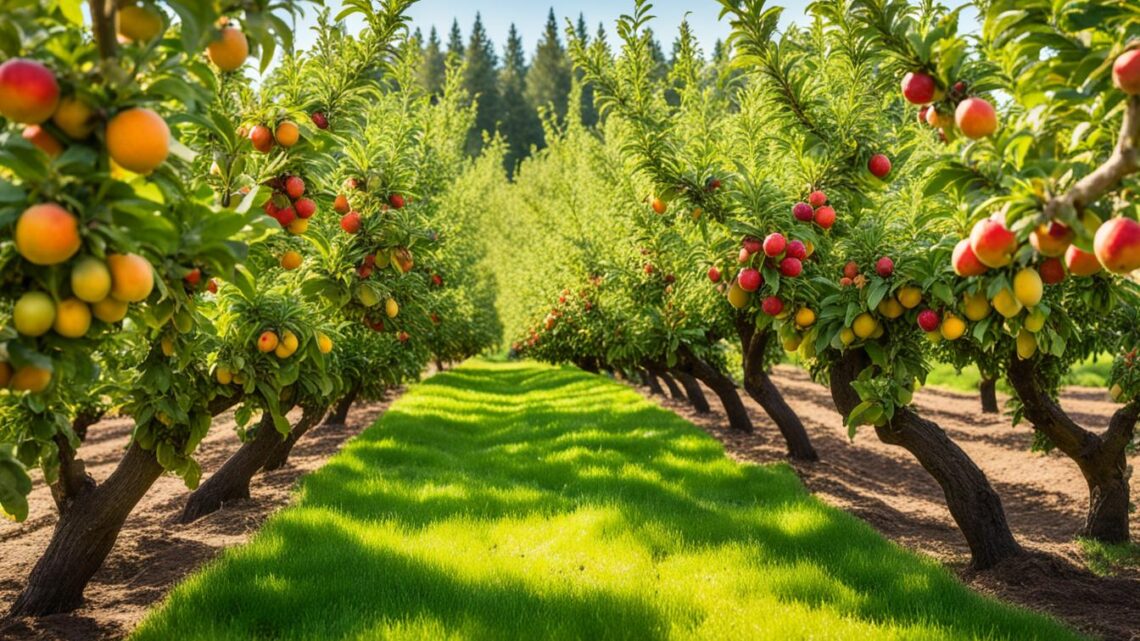
Do you dream of having lots of fruit from your own trees? But, you’re not sure how to keep them healthy? Susan Poizner from Toronto, Canada, is here to help. She knows a lot about growing fruit trees the right way.
She talks about organic care, food forests, and permaculture. These methods can make your fruit trees grow strong and give lots of fruit.
Fruit trees like apples, pears, peaches, and citrus are great for gardens. They can give you yummy fruit for many years. But, you need to plant them right, take good care of them, and give them the best conditions. This guide will give you the tips and strategies you need for healthy fruit trees.
Importance of Proper Research for Fruit Tree Selection
Choosing the right fruit tree is key for its success. Before buying a tree, learn about its climate, space, and pollination needs. Different trees do well in different places. Picking the right tree for your area helps with growth and fruit production.
Climate and Space Considerations
Most fruit trees need six hours of sunlight a day to do well. Look at your garden to find the sunniest spots for your trees. Soil’s nutrients and organic matter are also crucial. Good soil means healthy trees and more fruit.
Some trees are perfect for dry or humid climates. Apricot and pomegranate trees like dry areas, while orange and mango trees prefer humid ones. For small gardens, choose dwarf trees that won’t get too big.
Self-Pollinating vs. Cross-Pollinating Varieties
Knowing how trees pollinate is key for fruit production. Some trees pollinate themselves, others need another tree to help. Find out what your tree needs to know if you’ll need two trees or just one.
| Fruit Tree | Pollination Type | Recommended Companion Tree |
|---|---|---|
| Apple | Cross-pollinating | Another apple variety |
| Pear | Cross-pollinating | Another pear variety |
| Cherry | Self-pollinating | N/A |
| Peach | Self-pollinating | N/A |
Researching your fruit trees’ needs ensures a great harvest for years.
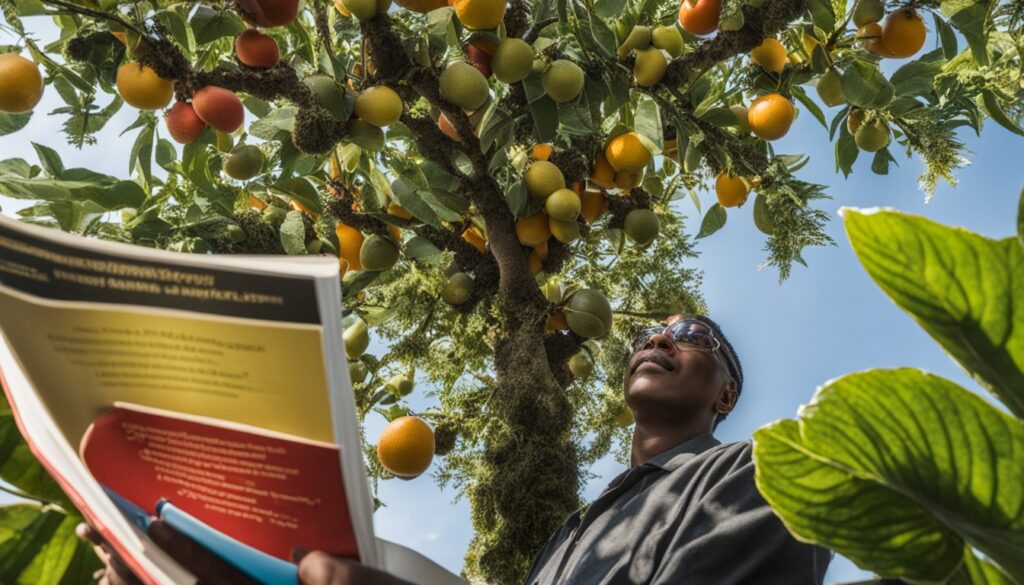
Providing Extra Care for Young Trees
Starting a fruit tree orchard needs extra care, especially in the first few years. As a new owner, focus on watering, keeping pests away, and protecting from bad weather. This ensures your trees grow strong and healthy.
Watering and Protection from Pests
Young fruit trees have small roots that need steady moisture to grow well. Make sure to water them often, but not too much. Check the soil to see if it’s dry before watering again.
You also need to keep pests away from your young trees. Use things like tree wraps or wire mesh to guard the trunk from animals. Check for bugs or diseases often and deal with them fast.
| Watering Tips for Young Fruit Trees | Pest Protection Strategies |
|---|---|
|
|
Give your young fruit trees the right water and protect them from pests. This will help them live a long, healthy life.
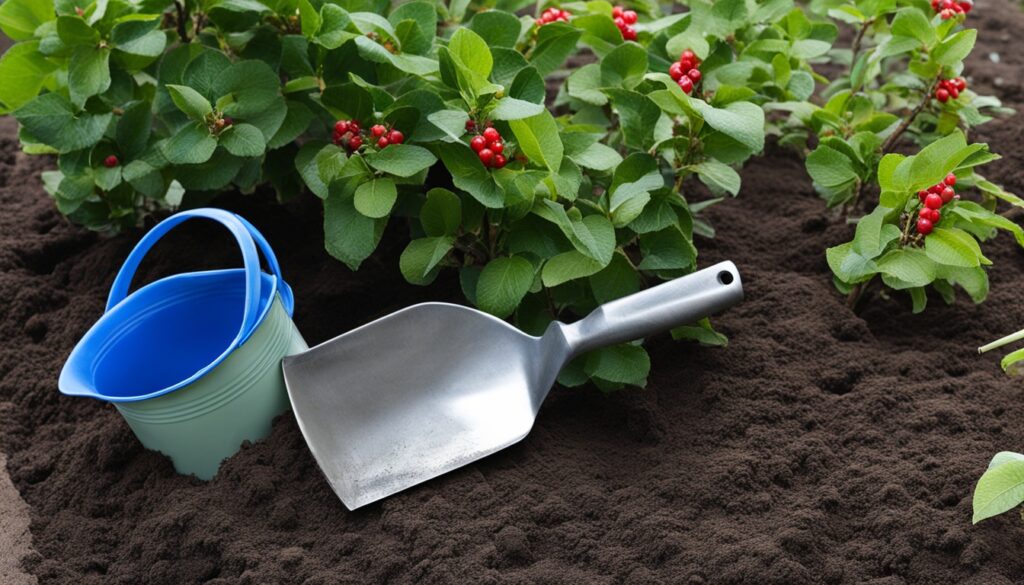
Correct Pruning Techniques
Proper pruning is key for a fruit tree to stay healthy and productive. It lets leaves get more light, cuts down on messy growth, and helps the tree produce bigger, juicier fruit. It’s important to remove dead wood and thin out branches that cross each other. But, each fruit tree species needs its own special pruning methods. So, make sure to learn what’s best for your tree type.
Improving Light Access and Fruit Production
Pruning a tree makes it grow stronger and fuller, making it bigger than an unpruned tree in one season. Cutting branches at 10 o’clock and 2 o’clock helps prevent the tree from splitting. Pruning to outward-facing buds lets trees spread out. This can improve light access and fruit production.
| Pruning Technique | Benefits |
|---|---|
| Central-Leader Training | Suitable for trees with few branches at planting, increases crotch strength and induces early fruit production. |
| Espalier Training | Allows for two-dimensional tree development, saving space and enhancing aesthetics. |
| Thinning Out Long Shoots | Results in flexible limbs that bend when loaded with fruit. |
Prune in late fall, winter, or early spring, depending on where you live. The exact time can vary. Different trees like apples, pears, peaches, and nectarines need specific pruning shapes. This includes central leader or vase-shape/open center for best growth and fruit production.

Pruning your fruit trees every dormant season is key for growth and production. If left unpruned, trees can become homes for pests. Keeping your tree healthy and well-pruned is vital for improving light access and fruit production.
Mulching and Fertilizing Guidelines
Keeping fruit trees healthy and productive needs a good plan for mulching and fertilizing. Using the right mulch and fertilizer can greatly improve your orchard’s health and fruit yield.
For mulching, putting mulch around your fruit trees is key. Cedar bark mulch is great because it lasts long and keeps soil moist. Hardwood mulches like hickory and oak also help, giving nutrients as they break down. But, avoid pine mulch because it makes soil too acidic, which hurts fruit trees.
- Cedar bark mulch is a durable option that helps retain soil moisture.
- Hardwood mulches like hickory and oak break down over time, releasing valuable nutrients.
- Pine mulch is not recommended for fruit trees as it can increase soil acidity.
Feeding your fruit trees is also crucial. Feed older trees in late winter or early spring. They need lots of nutrients for new growth and fruit. A good fertilizer, like 10-10-10 or 20-20-20, is perfect for them.
Young trees do better with a fertilizer rich in nitrogen, like 12-6-6. This helps them grow fast.
| Nutrient | Importance for Fruit Trees |
|---|---|
| Nitrogen (N) | Promotes lush foliage and overall plant growth. |
| Phosphorus (P) | Supports root development and fruit production. |
| Potassium (K) | Enhances overall plant health, including disease resistance and winter hardiness. |
Feeding your fruit trees with a balanced, slow-release fertilizer is key for their health and productivity. By using the right mulch and fertilizer, your fruit trees will grow well and give you lots of fruit every year.
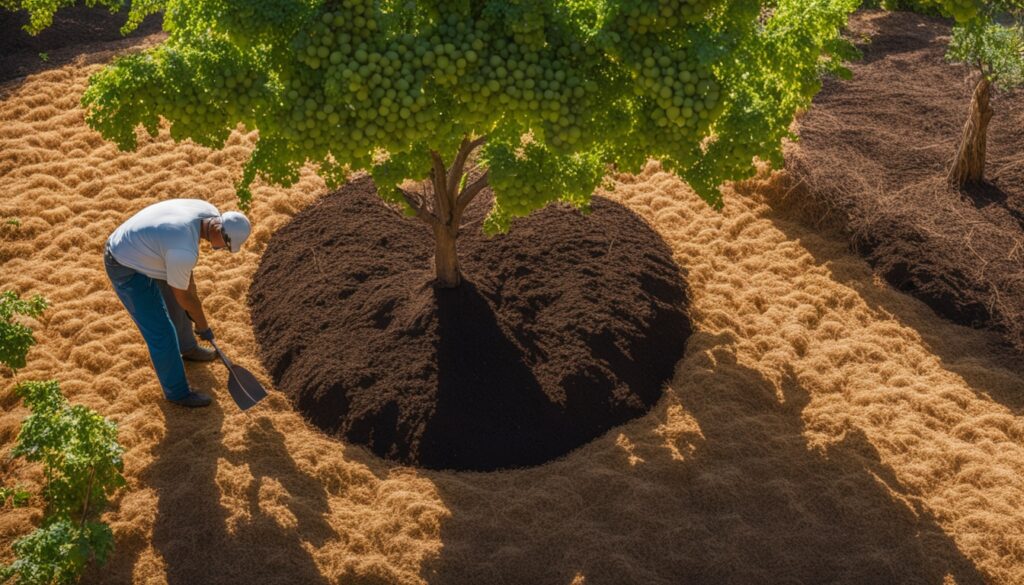
Disease and Pest Management Strategies
Keeping your fruit trees healthy is very important. It’s key to tackle disease and pest problems early. Knowing the common issues your trees face and treating them fast can save the day. Using organic ways to control pests and making your trees strong can prevent many problems.
Preventing Problems and Quick Identification
Be alert and learn about pests and diseases that hit your fruit trees. Fruit tree pests like aphids and leaf rollers can be big trouble. Fruit tree diseases like fungal scab can hurt your trees a lot. Watching your trees closely and fixing problems fast is a must.
Using organic pest control and disease prevention methods helps a lot. This includes using good bugs, safe pesticides, and keeping your trees clean. A full approach keeps your trees healthy for a long time.
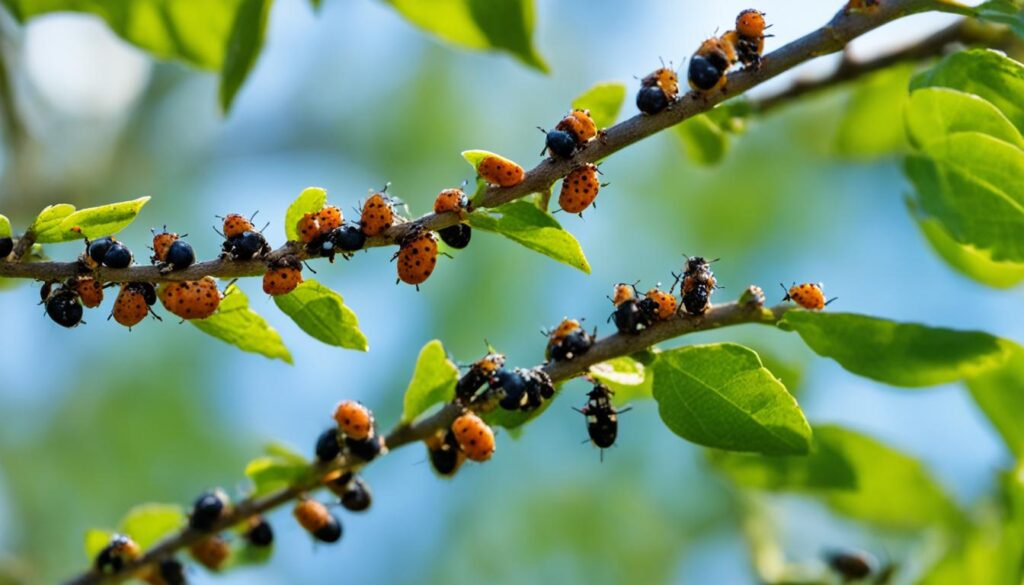
Looking at trusted sources like the PNW Pest Management Handbook and the WSU Extension Hortsense is smart. They offer tips on pests and diseases, along with safe ways to deal with them. Being informed and acting quickly keeps your fruit trees in top shape.
tips for healthy fruit trees
To get a lot of fruit from your trees, you need patience and hard work. With the right steps, your trees will stay healthy and give lots of fruit for many years. Here are key tips to keep your fruit trees growing well:
Proper Watering and Soil Moisture Monitoring
Give your new fruit trees lots of water right after planting. You should water them up to six times the first day to soak the soil well. A moisture meter (about $10) can tell you if the soil is too dry or too wet. Check the soil’s moisture once a week when your trees are growing.
Mulching and Fertilizing
Putting a 4- to 6-inch layer of organic mulch around the tree helps keep the soil moist and stops weeds. For the first few years, use a fertilizer with more nitrogen (like a 16-4-8 mix) to help the tree grow. Later, switch to a fertilizer with less nitrogen (a 3-12-12 mix) to help with roots, flowers, and fruit.
Proper Pruning Techniques
Pruning is key to keeping your fruit trees healthy and productive. Do two prunings a year – one in summer (May to August) for size control, and another in winter or early spring for detailed shaping. Pruning lets more light in and can increase fruit production.
Pest and Disease Management
It’s important to spot and fix pest and disease problems fast. Talk to experts or use trusted sources to figure out and treat any issues. Choosing trees that resist diseases can also prevent many problems.
By using these tips, you can make a great orchard. It will give you lots of fresh, homegrown fruit for many years.
Understanding Chill Hours and Fruit Tree Dormancy
Fruit trees like apples, cherries, apricots, peaches, and plums need chill hours to bloom and bear fruit. Chill hours are the time spent in cold weather during winter. This is when the tree is dormant.
It’s key to know how many chill hours your fruit tree needs. This is especially true for gardeners in warm areas. Chill hours help break dormancy and improve fruit quality and health.
Chill hours are counted when the temperature is below 45°F (7.2°C) in winter. Most fruit and nut trees need chill hours each winter to grow right. Trees needing more chill hours do well in cooler places. Those needing fewer chill hours are better in warmer areas.
Make sure to pick a fruit tree that fits your climate’s chill hours. You can find chill hour info in the tree’s details. Local Extension Agents can also help with plant hardiness and chill hour needs.
Chill hours can change from year to year. They depend on your area’s winter weather. Other things like tree age, nutrition, and pollination also affect fruit set.
Choosing the right fruit trees for your climate is important. This way, you can grow fruit even in warm places.
Fruit Tree Pollination Requirements
Knowing how your fruit trees pollinate is key for a good harvest. Some trees like peaches and sour cherries can pollinate themselves. But most apples and pears need another tree to help them produce fruit.
Self-Pollinating and Cross-Pollinating Trees
Many peach and tart cherry trees can pollinate themselves. Quince and sweet cherry trees can too. But apples, pears, apricots, and many cherries and plums need another tree to pollinate them.
- Self-Pollinating fruit trees include most apricots, nectarines, peaches, and sour cherries.
- Fruit trees Requiring a Pollinator include most apples, pears, plums, and sweet cherries.
Plant two trees that can pollinate each other within 100 feet for best results. Even self-pollinating trees may do better with another tree nearby. Make sure to pick the right trees to plant together for a great harvest.
| Fruit Tree Type | Pollination Requirements |
|---|---|
| Apples | Most apple varieties require cross-pollination with a compatible variety for abundant harvests. |
| Cherries | Cherry tree varieties are generally self-fruitful and do not require cross-pollination. |
| Pears | Pairing pear varieties like Early Gold and Patten can enhance pollination rates for a more abundant harvest. |
| Plums | Some plum tree varieties, such as Black Ice, La Crescent, Pipestone, and Superior, need Toka plum for cross-pollination, while Waneta plum requires the Black Ice variety. |
By looking into the pollination needs of your fruit tree pollination and planting the right trees together, you can get a great harvest.
Rootstock Selections for Desired Tree Size
The rootstock you pick is key to growing healthy fruit trees. It affects the tree’s size and traits. You can choose from dwarf (8-10 feet tall) to semi-dwarf (12-15 feet) to standard (over 25 feet) trees.
Choosing the right fruit tree rootstock is crucial for your garden or orchard. Dwarfing rootstocks like Bud9 make trees 20-25% smaller than M.9 337. G.935 is a bit bigger than M.26 and similar to M.9 337 in size.
| Rootstock | Relative Tree Size | Notable Characteristics |
|---|---|---|
| G.11 | 8-10 feet | Reported to perform better than M9.337 in 8th leaf trees |
| Bud.9 | 15-25% smaller than M.9 | Less susceptible to fire blight |
| M.9 337 | 30% of a seedling’s size | Widely used dwarfing rootstock |
| G.935 | Slightly larger than M.26 | Equal in production efficiency to M.9 |
| G.214 | Comparable to G.11 and G.41 | In the M9.337 size class |
The rootstock and interstems you choose affect fruit tree vigor and growth. Consider soil, drainage, disease resistance, and environmental conditions when picking a rootstock.
By selecting the right dwarf fruit trees, semi-dwarf fruit trees, or standard fruit trees rootstock, your orchard or garden will flourish. You’ll get healthy, productive, and easy-to-manage fruit trees that meet your needs.
Choosing Disease-Resistant Varieties
Choosing the right fruit trees is key to growing healthy ones. Instead of picking trees from the supermarket, look for specialty ones that fight off diseases easily. These trees need less care and are great for organic gardens.
Some top picks for disease-resistant fruit trees are:
- Peaches: Alberta, Belle of Georgia, Redhaven
- Nectarines: Hagan Sweet, Morton
- Plums: Greengage, Ozark Premier, Redheart, Stanley
- Cherries: Mazzard rootstock
- Apples: Liberty, MacFree, Prima, Priscilla, Tydeman’s Early Red
These trees are made to beat diseases like scab and fire blight. They grow well without chemicals and give you more fruit.
Avoiding Supermarket Fruit Tree Varieties
Supermarket trees look good but often don’t fight diseases well. Choosing special trees helps your trees grow strong and gives you lots of fruit every year.
| Fruit Tree Species | Chill Hour Requirements | Hardiness Zones |
|---|---|---|
| Figs, Pomegranates, Quince, Persimmons | 300 chill hours or less | Zones 7-11 |
| Apples (Anna, Dorsett, Sundowner) | Low chill hour requirements | Zones 4-9 |
| Apricots (Gold Kist, Katy) | Low chill hour requirements | Zones 5-8 |
| Plums (Methley, Beauty, Burgundy, Satsuma, Santa Rosa, Mariposa) | Higher chill hour requirements | Zones 5-9 |
By picking trees that fight diseases, you help them grow strong. This way, you get a bountiful, healthy harvest for many years.
Bare-Root vs. Potted Fruit Trees
Choosing between bare-root and potted fruit trees can greatly affect your garden’s success. Bare-root trees are often better for your orchard. They are healthier and cheaper. Bare-root fruit trees offer many advantages.
Benefits of Bare-Root Trees
Bare-root trees are healthier and cheaper. They don’t have their roots in a pot, so they can grow strong roots easily. Cutting the top third of a bare-root tree helps it grow a strong base.
- Bare-root trees cost 30-50% less than container-grown trees of the same size.
- Bare-root trees contain 200% more roots than trees sold balled-and-burlapped, according to Cornell University.
- Planting bare-root trees can lead to quicker growth as compared to containerized trees because roots don’t have to transition from container soil.
Plant bare-root trees in late winter or early spring when they are dormant. They are easy to ship and cost less. This makes them a smart choice for gardeners.
| Characteristic | Bare-Root Fruit Trees | Potted Fruit Trees |
|---|---|---|
| Root System | Robust, fibrous, and resilient | Prone to circling and root strangling |
| Soil Composition | Grown in prepared soil with compost and high organic content | Potting mix often consists of shredded bark, perlite, vermiculite, and peat moss |
| Fertilization | Rely on natural, organic nutrients in the soil | Require regular application of chemical fertilizers |
| Watering Needs | Require less frequent irrigation | Demand almost daily watering |
| Survival Rates | Over 90% of bare-root stock survive | Containerized trees likely above 99% alive after one year |
Bare-root and potted fruit trees both can do well. But bare-root trees have many benefits. They have healthier roots, cost less, and are easier to plant. Knowing these benefits can help you choose the best trees for your garden.
Optimal Planting Times for Different Climates
Planting fruit trees at the right time depends on your local climate. In warm areas, fall is best for planting. This lets trees grow roots before the hot summer. In cool areas, plant in late winter or early spring. This helps trees grow during the mild spring months.
Timing is key, no matter the climate. Good soil preparation is also vital. It helps trees grow strong and gives you lots of fruit later.
Knowing when to plant in warm or cold areas is important. It affects your orchard’s health and how much fruit you get. Picking the best time to plant gives your trees a great start. You’ll enjoy the fruits of your hard work for many years.



